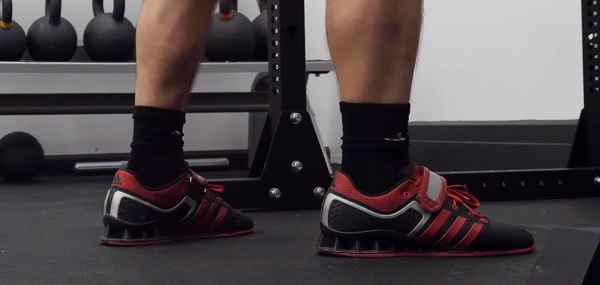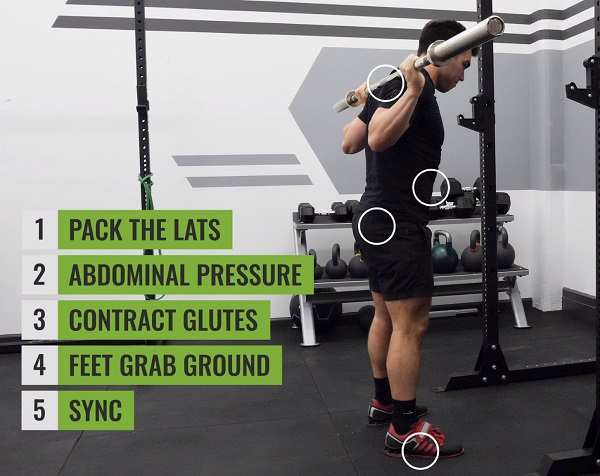There’s a lot that goes into a great squat. The un-rack, walkout, descent, and ascent all need to be perfectly aligned to move efficiently under a loaded bar.
An important lesson to learn under the barbell is that no two squats will ever look exactly the same, however, there are squat principles that should be carried out across every athlete’s form. An incredibly useful training tool for doing this and being consistent under the bar is building a string of squat cues and steps to follow every workout to increase proficiency.
In this article and video, we had two-time IPF World Champion Taylor Atwood take us through his favorite steps for executing great squats. Did we mention that on top of his two World Championships, Atwood also owns the IPF Open squat world record with a massive 283kg lift? We think it’s safe to say that Atwood knows a thing or two about squatting big weight.
7-Steps to the Perfect Squat
1. Hand Placement and Lats
Atwood’s first step for nailing the squat has to do with hand placement and packing the lats.
He recommends finding a hand width that allows you to maintain a packed lat position and stay consistent throughout every rep. For Atwood, he uses the rings to assess his hand width and points out that doing so is a great tool for staying consistent across multiple training days.
2. Bar Placement
Bar placement will vary for different athletes based on the squat style chosen to perform.
In the high-bar squat, the bar will lay across the traps, while in the low-bar, the bar lies across the posterior deltoids. For this step, Atwood recommends consistently positioning the bar in the style in which you squat. Since Atwood is a powerlifter, he utilizes a low-bar position and then matches his bar placement with his grip width and packed lats to get the bar sitting over the mid-foot.
Basically, he positions the bar on his back so it’s over the mid-foot when standing up with weight. His grip width, bar placement, and lats are all manipulated to create this positioning.
3. Walkout
Once you’ve positioned the bar on your back and have a packed posture, it’s time to walkout the squat.
Atwood likes and recommends using the 3-step walkout. This walkout is generally easy to accomplish and it helps limit energy dissipation due to taking too many steps. A walkout will be highly individual, and your 3-step walkout might look slightly different than what’s displayed in this video due to differences in squat styles, racks, and gym setup.
Once you’ve gotten your position and your hips and mid-foot are under the bar, it’s time to walk out the weight.
- Step One: Take a small step back with the first foot. You can use whichever foot you prefer and it’s important to go with what’s most comfortable and natural for you.
- Step Two: Take a second, slightly longer step with the opposing foot.
- Step Three: Take a small step with the first foot to align your stance and to nail an even position with the feet.
If you’re brand new to the 3-step walkout, then work this process with lighter weight to acclimate yourself to a new walkout style.

4. Breath
Breath is hugely important for the squat.
Atwood’s fourth step is once you’ve unracked the bar, walked the weight, and taken your position, is to take a deep belly breath to increase your intra-abdominal pressure. He points out that your breath should fill the belly and obliques, and to avoid only breathing into the chest, as this can then move the barbell.
5. Brace
To be efficient under the barbell, you have to brace properly.
For the squat, Atwood stresses that bracing is one of, if not the most important cues for success. A strong brace is much more than simply creating intra-abdominal pressure and it’s actually a sequence of multiple body parts and cues stacking on top of one another to create full body tension.
Five keys for nailing full body tension include packing the lats, creating intra-abdominal pressure, contracting the glutes, gripping the floor with the feet, and syncing all of these together.
6. Descent
Once you’ve braced, Atwood states that you’re going to actively think about maintaining that full body tension while controlling the descent. Avoid dive bombing the movement and load the body evenly throughout the full eccentric.
7. Ascent
After you’ve descended and you’re in the hole of the squat, it’s time to shift into the ascent, or the concentric phase of the movement. For the ascent, Atwood likes to keep three things in mind.
- Be explosive. Once depth is achieved, Atwood likes to think about being as powerful and explosive out of the hole as possible.
- Maintain tension. Explosive doesn’t mean loose, so once he’s shifting into an explosive thought process, he still attempts to maintain tension and postures throughout the full eccentric-to-concentric shift. This means maintaining intra-abdominal pressure until successfully executing the concentric movement pattern.
- Drive through the mid-Foot. Now that you’re thinking about being explosive and you’ve maintained tension, Atwood recommends putting it all together by driving through the mid-foot. This assists with the maintenance of lifting postures, along with power production.
Building a Perfect Squat
A perfect squat is the culmination of multiple factors stacking up and aligning to produce one successful movement.
When it comes to building your squat, it’s useful to incorporate multiple steps to create consistency across the board. Typically, no two days feel exactly the same in the gym, so having a string of cues to follow every squat session is useful for creating consistent movement patterns and mindsets for both good and bad squat sessions!

